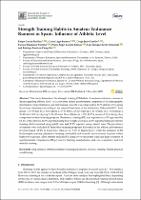Por favor, use este identificador para citar o enlazar este ítem:
https://repositorio.usj.es/handle/123456789/473
Registro completo de metadatos
| Campo DC | Valor | Lengua/Idioma |
|---|---|---|
| dc.contributor.author | García-Pinillos, Felipe | - |
| dc.contributor.author | Lago-Fuentes, Carlos | - |
| dc.contributor.author | Jaén-Carrillo, Diego | - |
| dc.contributor.author | Büjalance-Moreno, Pascual | - |
| dc.contributor.author | Latorre-Román, Pedro Á. | - |
| dc.contributor.author | Roche-Seruendo, Luis Enrique | - |
| dc.contributor.author | Ramirez-Campillo, Rodrigo | - |
| dc.date.accessioned | 2021-02-12T13:56:48Z | - |
| dc.date.available | 2021-02-12T13:56:48Z | - |
| dc.date.issued | 2020-11-05 | - |
| dc.identifier.citation | García-Pinillos, F., Lago-Fuentes, C., Jaén-Carrillo, D., Bujalance-Moreno, P., Latorre-Román, P.Á., Roche-Seruendo, L.E., Ramirez-Campillo, R., 2020. Strength Training Habits in Amateur Endurance Runners in Spain: Influence of Athletic Level. International Journal of Environmental Research and Public Health 17, 8184.. doi:10.3390/ijerph17218184 | es_ES |
| dc.identifier.issn | 1661-7827 | es_ES |
| dc.identifier.uri | https://repositorio.usj.es/handle/123456789/473 | - |
| dc.description.abstract | This study determined the strength training (ST) habits of amateur endurance runners in Spain regarding athletic level. A sixteen-item online questionnaire comprised of (i) demographic information, (ii) performance, and (iii) training contents was completed by 1179 athletes. Five group levels were determined according to the personal best times of the athletes in a 10-km trial (LG1: level group 1, 50–55 min; LG2: level group 2, 45–50 min; LG3: level group 3, 40–45 min; LG4: level group 4, 35–40 min; LG5: level group 5, 30–35 min). Most athletes (n = 735, 62.3%) perceived ST as being a key component in their training program. Resistance training (RT) was reported as a ST type used by 63.4% of the athletes, 66.9% reported using bodyweight exercises, 46.8% reported using plyometric training, 65.6% reported using uphill runs, and 17.8% reported using resisted runs. The prevalence of runners who excluded ST from their training programs decreased as the athletic performance level increased (18.2% in lower-level athletes vs. 3.0% in higher-level), while the inclusion of RT, bodyweight exercises, plyometric training, and uphill and resisted runs was more frequent within higher-level groups. Most athletes included ST using low-to-moderate loads and high a number of repetitions/sets comprised of RT, plyometric training, resisted runs, and core, respiratory, and foot muscles training. | es_ES |
| dc.format.extent | 12 p. | es_ES |
| dc.format.mimetype | application/pdf | es_ES |
| dc.language.iso | eng | es_ES |
| dc.publisher | MDPI AG | es_ES |
| dc.rights | Atribución 4.0 Internacional | * |
| dc.rights.uri | http://creativecommons.org/licenses/by/4.0/ | * |
| dc.subject | Long-distance athletes | es_ES |
| dc.subject | Resistance training | es_ES |
| dc.subject | Plyometric exercise | es_ES |
| dc.subject | Running | es_ES |
| dc.subject | Human physical conditioning | es_ES |
| dc.title | Strength training habits in amateur endurance runners in spain: Influence of athletic level | es_ES |
| dc.type | info:eu-repo/semantics/article | es_ES |
| dc.subject.unesco | Investigación | es_ES |
| dc.identifier.doi | 10.3390/ijerph17218184 | es_ES |
| dc.rights.accessrights | info:eu-repo/semantics/openAccess | es_ES |
| Aparece en las colecciones: | Artículos de revistas | |
Ficheros en este ítem:
| Fichero | Descripción | Tamaño | Formato | |
|---|---|---|---|---|
| Strength training habits in amateur endurance runners in spain.pdf | 1,93 MB | Adobe PDF |  Visualizar/Abrir |
Este ítem está sujeto a una licencia Creative Commons Licencia Creative Commons

